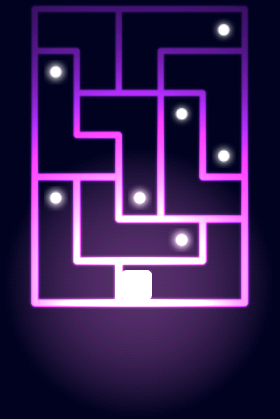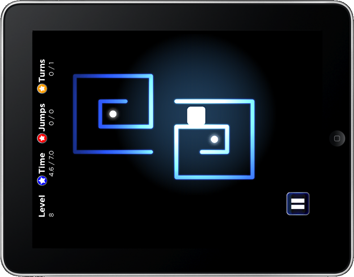Development

The Game Idea The game basically consists of a number of game ideas mixed together:
1. Pac-Man as a 2-D platformer
If you look at a screenshot from Pac-Man and imagine that what you see is not a top view of a maze, but instead a side view of a 2-D platform game. How would the gameplay be? Some walls would now be platforms, and in order to reach the upper platforms, the hero would have to be able to jump.
2. World flipping
A few Calvin and Hobbes stories plays with the idea that gravity suddenly flips and that the ceiling becomes the floor and vice versa. Wouldn't it be cool to make a game about that? Alright, somebody already did that. But doing it on a handheld device allows the player to flip the entire screen 90 degrees.
3. Choose your spawn point
Airborne Ranger, an old classic game for Commodore 64 and Amiga featured large levels and allowed the player to decide where they wanted to spawn on the level. I have always wanted to include this feature, since it allows great freedom and replayability.

Game Design
It was decided early on to keep the game simple. We wanted to give the player the feeling that the game is both easy to pick up and easy to master, and the word became a keyword in game design decisions. It's easy to aim for simplicity but rather hard to keep focused on. We had a lot of new ideas as we progressed with the game, and it proved to be a challenge to keep the eyes on the ball and not implement additional features.
Another keyword was neutral. Early prototype testing showed that men and women found the game equally entertaining. Neon Zone has a unisex appeal, so we chose to use neutrality as a key game design factor. An example of this is the hero character, which is a featureless white cube.
Making Levels
The levels were initially made with pen and paper, for the simple reason that paper is easy to flip 90 degrees. Using pen and paper also allowed us to make levels outside the office, and quite a few level layouts have actually been produced on lengthy train and plane rides.
The levels were mainly designed by Linda and Thomas, and their individual style can easily be identified throughout the game. Thomas would typically make visually pleasing symmetric levels that can be solved in one or two ways and Linda would make odd assymetrical levels which can be solved in 20 ways. The contrasting styles adds great variety to the game.
The Worlds

Inspired by the initial title for the game, Neon, Linda came up with the idea of using noble gasses as themes for the game worlds. Neon is just one of 7 noble gasses which also counts Radon and Krypton among others. Some of the colours used in the worlds correspond to the colours of the emission lines of the individual gasses. For instance Krypton has mainly green and yellow emission lines, which lead to a greenish world in the game.
The Visuals
When deciding the visual style for the game it became apparent early on that we could never come up with a sensible story for the game. It's an abstract game, and instead of trying to hide that fact, we decided to try to emphazise it through the graphics. We also chose to embrace the simpleness and the emotionless nature of the game by aiming for a very neutral look. Tron Legacy had just premiered at the time we decided to make the game, and the cool neon style seemed a perfect fit for our gameplay. It's cool and modern, and equally appealing to both men and women.

Sound Effects
Before diving into the sound production we had to decide in which world this game was taking place in order to create the right soundscape. It's hard to describe a place that is basically abstract, so we decided to call it 'The dark side of Pluto'.
Nevin, the sound designer, suggested playing a different sound effect each time the player picks up a sphere. There are 10 pickup sounds which are being played in random order, which, when played frequently almost makes little melodies by themselves.
The soundtrack was composed after the sound effects were made. The sounds were very powerful and frequently played, so we decided for a very subtle soundtrack which would allow for the sound effects to be in focus. The chords played in the soundtrack are neither minor or major chords, as we didn't want to dictate whether the player should feel happy or sad when playing the game. This also corresponds with the overall neutral theme of the game.

